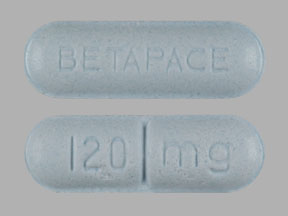Betapace Interactions
There are 645 drugs known to interact with Betapace (sotalol), along with 20 disease interactions, and 3 alcohol/food interactions. Of the total drug interactions, 237 are major, 377 are moderate, and 31 are minor.
- View all 645 medications that may interact with Betapace
- View Betapace alcohol/food interactions (3)
- View Betapace disease interactions (20)
Most frequently checked interactions
View interaction reports for Betapace (sotalol) and the medicines listed below.
- albuterol
- amlodipine
- aspirin
- Aspirin Low Strength (aspirin)
- Coumadin (warfarin)
- digoxin
- Eliquis (apixaban)
- Flomax (tamsulosin)
- furosemide
- gabapentin
- Lasix (furosemide)
- levothyroxine
- Lipitor (atorvastatin)
- lisinopril
- losartan
- magnesium oxide
- metformin
- Norvasc (amlodipine)
- omeprazole
- Plavix (clopidogrel)
- potassium chloride
- prednisone
- Prilosec (omeprazole)
- Protonix (pantoprazole)
- simvastatin
- Synthroid (levothyroxine)
- Tylenol (acetaminophen)
- Vitamin D3 (cholecalciferol)
- warfarin
- Zoloft (sertraline)
Betapace alcohol/food interactions
There are 3 alcohol/food interactions with Betapace (sotalol).
Betapace disease interactions
There are 20 disease interactions with Betapace (sotalol) which include:
- bradyarrhythmia/AV block
- cardiogenic shock/hypotension
- CHF
- diabetes
- hypersensitivity
- ischemic heart disease
- PVD
- asthma/COPD
- hemodialysis
- QT interval prolongation
- renal dysfunction
- cerebrovascular insufficiency
- glaucoma
- hyperlipidemia
- hyperthyroidism
- myasthenia gravis
- pheochromocytoma
- psoriasis
- tachycardia
- Prinzmetal's variant angina
More about Betapace (sotalol)
- Betapace consumer information
- Compare alternatives
- Reviews (2)
- Drug images
- Side effects
- Dosage information
- During pregnancy
- Generic availability
- Drug class: group III antiarrhythmics
- Breastfeeding
- En español
Related treatment guides
Drug Interaction Classification
| Highly clinically significant. Avoid combinations; the risk of the interaction outweighs the benefit. | |
| Moderately clinically significant. Usually avoid combinations; use it only under special circumstances. | |
| Minimally clinically significant. Minimize risk; assess risk and consider an alternative drug, take steps to circumvent the interaction risk and/or institute a monitoring plan. | |
| No interaction information available. |
See also:
Further information
Always consult your healthcare provider to ensure the information displayed on this page applies to your personal circumstances.


